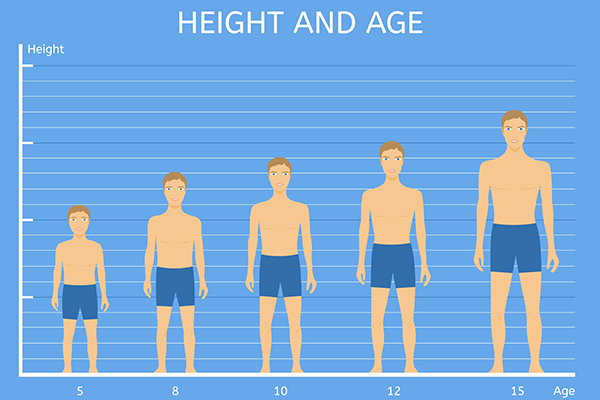When it comes to tracking growth and development during adolescence, understanding the average height for a 15-year-old can provide valuable insights. Height can vary among individuals due to factors such as genetics, gender, ethnicity, and overall health. In this article, we will explore the typical height range for 15-year-olds and shed light on important considerations related to growth patterns during this stage of life.
Is There Significant Growth in Late Adolescents?
Late adolescence is a remarkable period of tremendous growth, both physically and emotionally. It’s a time when young individuals undergo remarkable transformations that shape their lives and define their identities. It can be a rollercoaster of emotions, filled with excitement, confusion, and self-discovery.
Physically, late adolescents experience significant growth spurts. Their bodies go through rapid changes as they reach their full height, develop muscle mass, and undergo sexual maturation. These transformations can bring mixed emotions, as young individuals grapple with adjusting to their changing appearance and adapting to new physical abilities.
Emotionally, late adolescence is a time of intense self-exploration and identity formation. Young people begin to question their beliefs, values, and aspirations, searching for their place in the world. It can be a period of deep introspection and soul-searching as they try to understand who they truly are and what they want from life. This journey of self-discovery can be both exhilarating and challenging, as they navigate the complexities of relationships, friendships, and societal expectations.
Late adolescents also experience cognitive growth during this period. Their thinking becomes more abstract and sophisticated, allowing them to engage in complex reasoning, problem-solving, and decision-making. They develop a better understanding of their own emotions and those of others, which helps them navigate social interactions and build more meaningful relationships.
However, along with these exciting growth opportunities, late adolescence can also be a time of vulnerability and uncertainty. The pressure to succeed academically, choose a career path, or make life-altering decisions can be overwhelming. Anxiety, self-doubt, and fear of the future can take a toll on their emotional well-being. It’s important for young individuals to receive support, guidance, and encouragement from their families, friends, and mentors during this critical stage of their lives.
Despite the challenges, the growth experienced during late adolescence lays the foundation for a promising future. It’s a transformative phase where individuals discover their passions, develop their talents, and forge their own unique paths in life. Through self-reflection, resilience, and the support of their loved ones, late adolescents can harness their full potential and embrace the exciting opportunities that lie ahead.

What Are Elements Influencing Teenagers’ Height Increase Rate?
Ah, the height increase rate during teenage years! It’s an incredible journey filled with anticipation, hope, and sometimes a hint of anxiety. Several elements come into play, influencing how much a teenager grows during this period.
- Genetics: The most significant factor influencing height is genetics. Teenagers inherit their height potential from their parents and family. Genetic factors determine the growth plates in their bones and the timing and pace of their growth spurt. So, if their parents are tall, there’s a good chance they’ll experience considerable growth too.
- Nutrition: Adequate nutrition is crucial for healthy growth. Teenagers need a balanced diet rich in essential nutrients, especially proteins, calcium, and vitamins. These nutrients provide the building blocks for bone and muscle development. A diet lacking in these nutrients can hinder growth potential and lead to stunted height.
- Hormonal factors: Hormones play a vital role in height growth. During puberty, the body releases growth hormones, such as human growth hormone (HGH), which stimulate the growth plates in the long bones. The timing and intensity of these hormone releases can affect the rate of height increase. Imbalances or deficiencies in hormonal production can impact growth potential.
- Physical activity: Engaging in regular physical activity and exercise can have a positive impact on height growth. Weight-bearing activities, stretching exercises, and sports can promote bone health, muscle development, and overall growth. Physical activity also improves posture, which can make individuals appear taller and more confident.
- Sleep: Adequate sleep is essential for proper growth and development. During sleep, the body produces growth hormones that facilitate tissue repair and growth. Lack of sleep or poor sleep quality can disrupt the production of these hormones, affecting height increase rate.
- Environmental factors: Certain environmental factors can influence height growth. Factors like exposure to pollutants, toxins, or chronic illnesses can negatively impact growth potential. Additionally, socio-economic factors, access to healthcare, and overall living conditions can affect a teenager’s ability to maintain good health and, consequently, their height growth.
What is the typical height for 15-year-old boys and girls?
During adolescence, boys experience significant growth spurts that can last for one to two years. Around this age, their voices deepen, and they may start to develop facial hair. Additionally, they tend to build muscle quickly. On the other hand, most girls have reached their full height by this age.
Average height for 15-year-old boys
On average, the height of boys at 15 falls between 5 feet 0.87 inches (154.61 centimeters) and 6 feet 0.49 inches (184.13 centimeters). Therefore, the mean height for boys in this age group is approximately 5 feet 6.98 inches (170.14 centimeters)
Average height for 15-year-old girls
For girls at this age, their height typically ranges from 4 feet 11 inches (149.74 centimeters) to 5 feet 8.56 inches (174.15 centimeters). Thus, the average height for girls in this age group is around 5 feet 3.74 inches (161.9 centimeters)
How can you calculate BMI in children?
BMI, also known as Body Mass Index, is a measure used to assess body fat based on a person’s height and weight. However, the BMI standards for adults cannot be directly applied to children and teenagers. This is because kids are still in the process of growing, and there are variations in body fat between boys and girls.
For children, BMI is evaluated by comparing it to percentiles based on factors such as height, weight, sex, and age. You can utilize an online calculator to determine your child’s BMI, and then refer to the following classifications:
Underweight: BMI below the 5th percentile Healthy weight: BMI between the 5th and 84th percentiles Overweight: BMI between the 85th and 94th percentiles Obesity: BMI at or above the 95th percentile
Remember, these percentiles provide a better understanding of how your child’s BMI compares to other children of the same age and gender. It’s always recommended to consult with a healthcare professional for a comprehensive evaluation and guidance.
How to Get Taller at 15
In this heartfelt article, we will explore practical strategies that can help you on your journey to getting taller at 15. So let’s dive in and embrace the adventure of growth!

Ensure Proper Nutrition
A balanced diet rich in essential nutrients is vital for growth and development. Make sure your diet includes foods that promote bone health, such as dairy products, green leafy vegetables, fish, and lean meats. Calcium, vitamin D, protein, and other essential minerals and vitamins are crucial for optimal bone growth. Avoid excessive consumption of sugary and processed foods, as they provide little nutritional value and can hinder growth potential.
Get Adequate Sleep
Sleep plays a crucial role in overall growth and development. During deep sleep, the body releases growth hormone, which is essential for bone and muscle growth. Aim for a minimum of 8-10 hours of quality sleep each night. Establish a consistent sleep schedule, create a sleep-friendly environment, and avoid electronic devices before bedtime to ensure restful sleep.
Engage in Regular Exercise
While exercise alone may not directly increase your height, it promotes healthy bone development, posture, and overall well-being. Incorporate activities like swimming, cycling, jogging, and stretching into your routine. These exercises help strengthen your muscles, improve posture, and maintain a healthy weight, which can make you appear taller.
Practice Good Posture
Maintaining proper posture is essential for optimizing your height. Slouching can compress the spinal discs and lead to a shorter stature. Practice sitting and standing up straight, aligning your shoulders, spine, and hips. Engage in exercises that strengthen your core muscles, as a strong core supports good posture.
Avoid Factors That Can Stunt Growth
Certain factors can negatively impact your height potential. Avoid smoking, as it restricts blood flow and inhibits bone growth. Minimize alcohol consumption, as excessive intake can interfere with proper nutrient absorption. Additionally, avoid excessive caffeine intake, as it can disrupt sleep patterns and hinder growth.
Stay Hydrated
Proper hydration is essential for overall health, including bone and muscle development. Drink an adequate amount of water throughout the day to support optimal growth. Avoid excessive consumption of sugary beverages, as they can lead to weight gain and potentially hinder growth potential.
Seek Medical Advice
If you have concerns about your height or growth development, it’s important to consult a medical professional. They can evaluate your growth patterns, provide guidance on healthy lifestyle choices, and address any underlying medical conditions that may affect your height.
Embrace Confidence and Self-Acceptance
While it’s natural to desire increased height, it’s crucial to embrace self-acceptance and cultivate confidence regardless of your stature. Remember that height does not define your worth or abilities. Focus on developing your talents, skills, and personality, as these qualities contribute to your overall growth and success.
- Related post: 10 Effective Methods to Boost Your Height within a Week

Erik Kelly with more than 30 years of working in the field of technology and games. Erik Kelly will answer all your questions related to the latest technology products, new game reviews at Timrim.com website.